Korean culture is gaining worldwide recognition for its unique and healthy approach to food and lifestyle. From the simplicity of traditional Korean food to trendy fusion restaurants, Korean cuisine has become increasingly popular around the world. The Korean diet and lifestyle have been linked to their high life expectancy, which is one of the highest in the world.

In this blog, we will explore Korean culture’s diet habits and lifestyle. We have also listed some famous Korean restaurants around the world. And yes, we have curated five Korean recipes for you!
Korean Cuisine, Diet Habits & Lifestyle
Diet Habits:
Korean cuisine is well known for its balance of flavors and nutritious ingredients. Koreans traditionally consume a diet that is low in fat and high in fiber, with a focus on vegetables, fruits, and grains. Korean cuisine is also rich in fermented foods, such as kimchi, which contains beneficial probiotics for gut health. Koreans also consume a significant amount of seafood, which is high in omega-3 fatty acids and other essential nutrients. The food is typically prepared using healthy cooking methods such as grilling, boiling, and steaming.
Lifestyle:
Korean culture emphasizes a healthy lifestyle that includes regular exercise and socializing with friends and family. Koreans often participate in outdoor activities such as hiking and cycling, which are a part of their daily routine. Korean culture also places a strong emphasis on mindfulness and relaxation, with practices such as meditation and traditional Korean spa treatments.
A list of Famous Korean Restaurants around the World:
Jungsik (New York, USA)
Jungsik is a Michelin-starred restaurant that offers modern Korean cuisine with a fusion twist.

Baekjeong (Los Angeles, USA)
Baekjeong is a popular Korean BBQ restaurant that offers high-quality meats and traditional Korean side dishes.
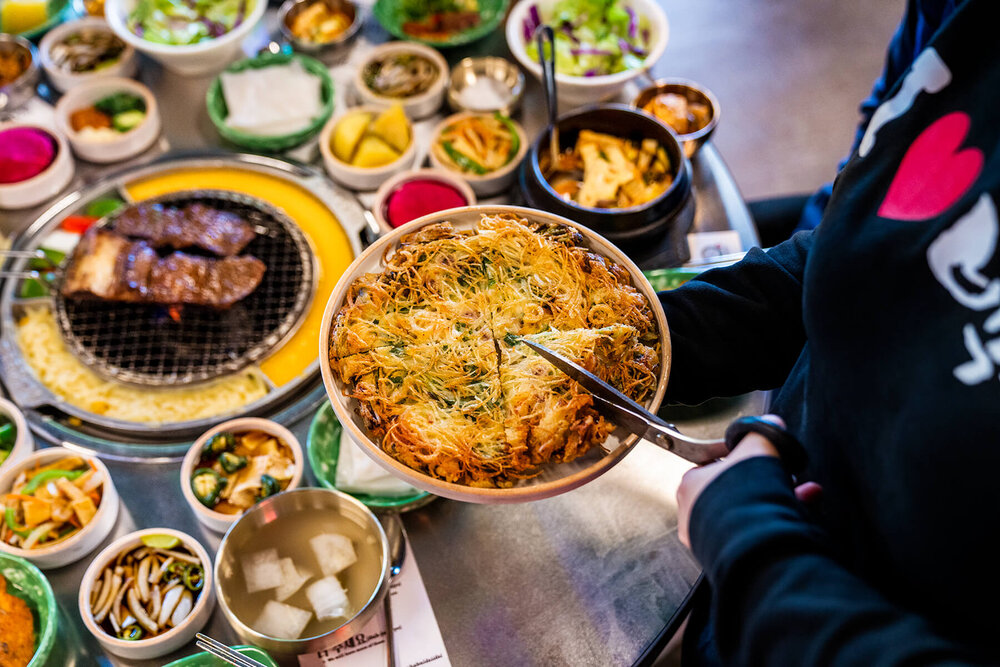
Gwangjang Market (Seoul, South Korea)
Gwangjang Market is a famous traditional Korean food market that offers a variety of street foods, including Korean pancakes and bibimbap.

Bibimbap Soho, London
Bibimbap Soho is a popular Korean restaurant located in the trendy Soho neighborhood of London. It is known for its delicious bibimbap, a Korean rice dish topped with a variety of vegetables, meat, and egg.
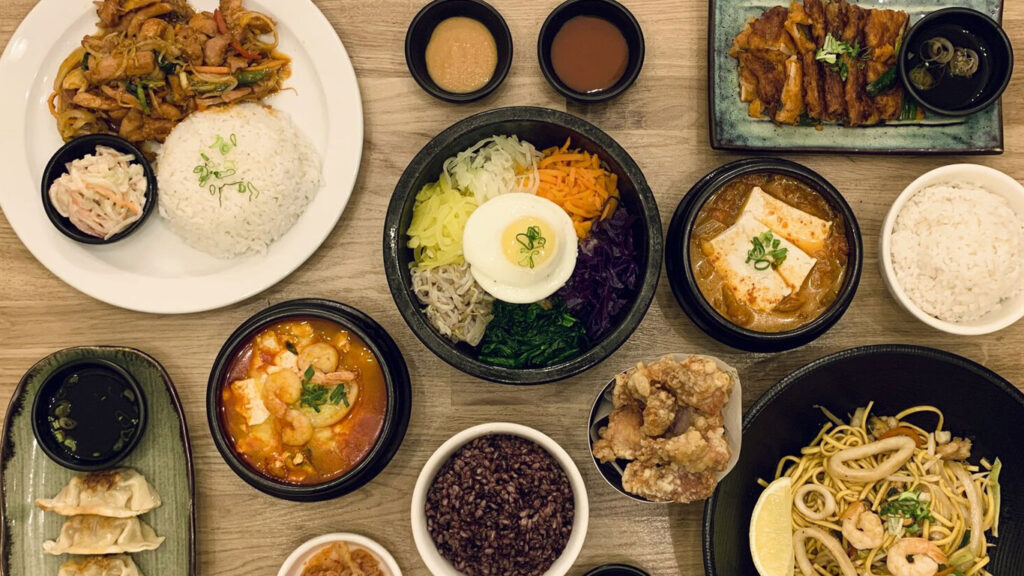
Jinjuu, London
Jinjuu is a modern Korean restaurant in London. It is known for its playful and contemporary take on traditional Korean dishes, as well as its trendy atmosphere and cocktails.
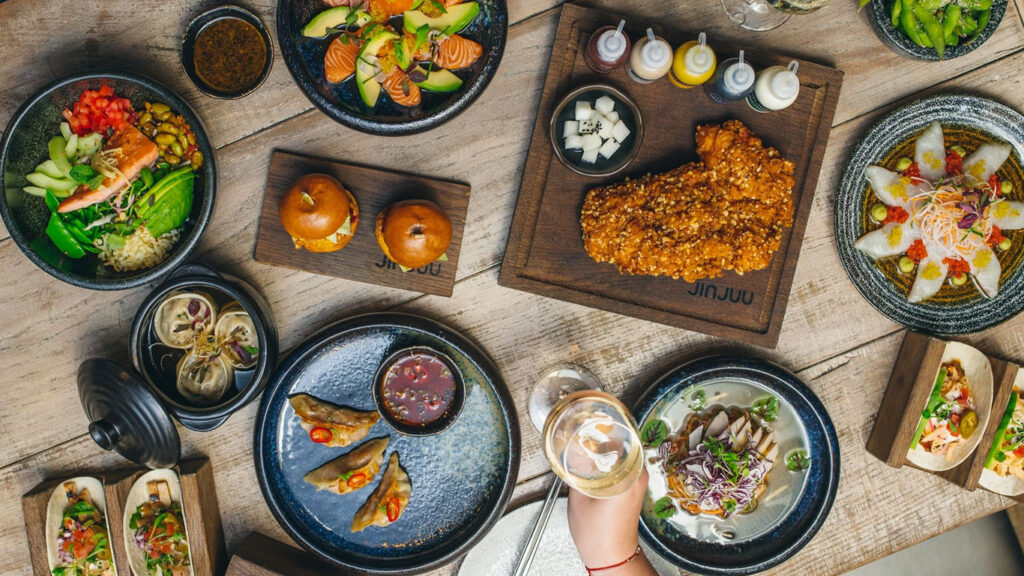
Korean Cuisine, 5 Recipes
1. Bibimbap (Mixed Rice Bowl) with Tofu
This dish is a popular Korean dish that consists of mixed rice, vegetables, and a protein of your choice. In this recipe, we have used tofu as a protein source instead of meat. You can use any vegetables you like, such as spinach, mushrooms, carrots, bean sprouts, and zucchini.
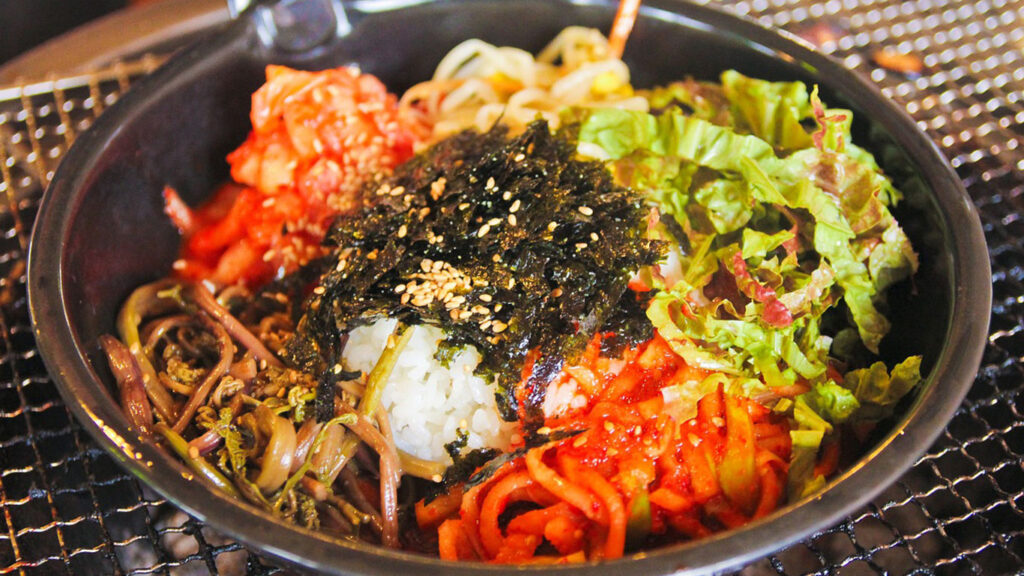
Ingredients:
- 2 cups cooked rice
- 1 package of firm tofu, sliced into small pieces
- 1 carrot, julienned
- 1/2 cup spinach
- 1/2 cup bean sprouts
- 1/2 cup shiitake mushrooms, sliced
- 1/2 cup zucchini, julienned
- 2 cloves garlic, minced
- 1 tablespoon sesame oil
- 1 tablespoon soy sauce
- 1 tablespoon gochujang (Korean chili paste)
- 1 tablespoon vegetable oil
- Salt and pepper, to taste
- 2 eggs, fried (optional)
Instructions:
Heat the vegetable oil over medium-high heat. Add the tofu to the pan and cook until lightly brown for about 3-4 minutes on each side. Set it aside.
In the same pan, add the garlic and cook until fragrant for about 30 seconds. Now add the carrot, zucchini, and shiitake mushrooms to the pan and cook until soft, about 5-7 minutes. Add the spinach and bean sprouts to the pan and cook for another 1-2 minutes. In a small bowl, mix together sesame oil, soy sauce, and gochujang. Add the cooked rice to a bowl and top with the cooked vegetables, tofu, and fried eggs (optional). Drizzle the sauce over the top of the bibimbap and enjoy this delicious meal.
2. Haemul Pajeon (Seafood Scallion Pancake)
This savory Korean pancake is made with a variety of seafood, scallions, and flour. It’s a great way to incorporate seafood into your diet and is perfect as a side dish or appetizer.
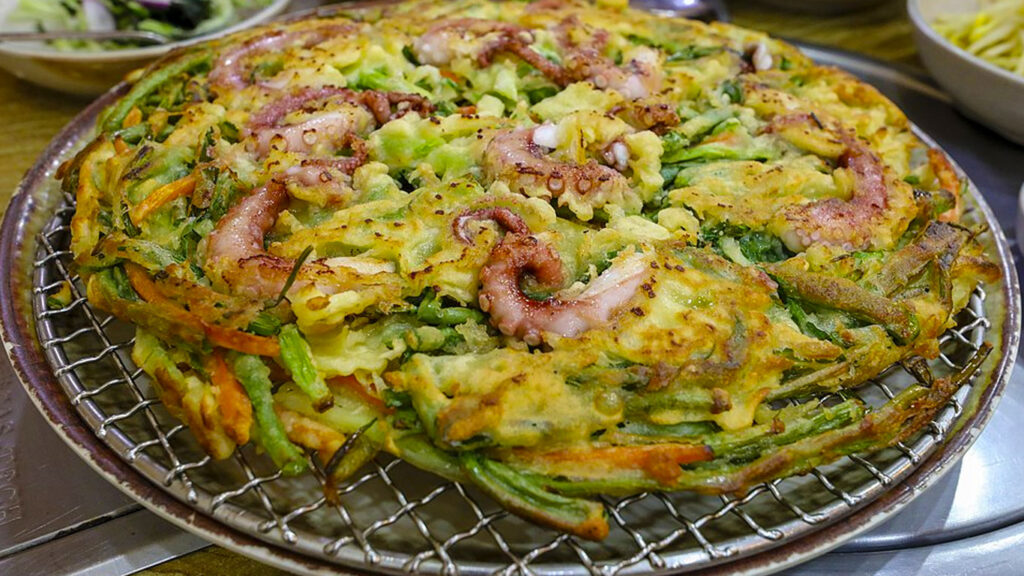
Ingredients:
- 1 cup all-purpose flour
- 1 cup water
- 2 eggs
- 1/2 teaspoon salt
- 1/4 teaspoon pepper
- 4-5 scallions, thinly sliced
- 1/2 cup seafood (such as shrimp, squid, or clams), cleaned and sliced
- Vegetable oil for frying
Instructions:
In a large mixing bowl, whisk together flour, water, eggs, salt, and pepper until smooth. Add sliced scallions and seafood to the batter and mix until even.
Heat a large non-stick pan or skillet over medium-high heat and add enough vegetable oil to coat the bottom of the pan. Pour the batter into the pan and spread it evenly to form a thin pancake. Cook for 3-4 minutes on each side, or until golden brown and crispy. Cut the pancake into small pieces and serve hot with soy sauce for dipping.
3. Japchae (Stir-Fried Glass Noodles)
Japchae is a popular Korean dish made with stir-fried vegetables, meat (optional), and glass noodles. In this recipe, we are omitting the meat and adding more vegetables.
Ingredients:
- 250g sweet potato starch noodles (Dangmyeon)
- 2 cloves garlic, minced
- 1 onion, thinly sliced
- 1 carrot, julienned
- 1 red bell pepper, julienned
- 4-5 shiitake mushrooms, thinly sliced
- 2 cups spinach
- 2 tablespoons vegetable oil
- 2 tablespoons soy sauce
- 2 tablespoons sugar
- 1 tablespoon sesame oil
- Salt and pepper, to taste
- Toasted sesame seeds, for garnish
- Green onions, thinly sliced, for garnish
Instructions:
Soak the sweet potato starch noodles in cold water for about 30 minutes until soft. Drain and set aside.
In a large bowl, mix together soy sauce, sugar, and sesame oil to make the sauce. Set aside.
In a large pan or wok, heat the vegetable oil over medium-high heat. Add garlic and onion to the pan and cook until fragrant. Now add carrot, bell pepper, and shiitake mushrooms to the pan and cook until soft for about 5-7 minutes. Add spinach to the pan and cook until wilted, about 1-2 minutes.
Add the drained noodles to the pan and stir-fry for 2-3 minutes until heated through. Pour the sauce over the noodles and vegetables and stir to combine. Season with salt and pepper to taste. Garnish with toasted sesame seeds and green onions before serving.
4. Dubu Jorim (Braised Tofu)
This dish is a simple and delicious way to prepare tofu. The tofu is braised in a soy sauce-based sauce with garlic, green onions, and chili flakes. It’s a healthy and flavorful dish that can be served as a side dish or as a main course.
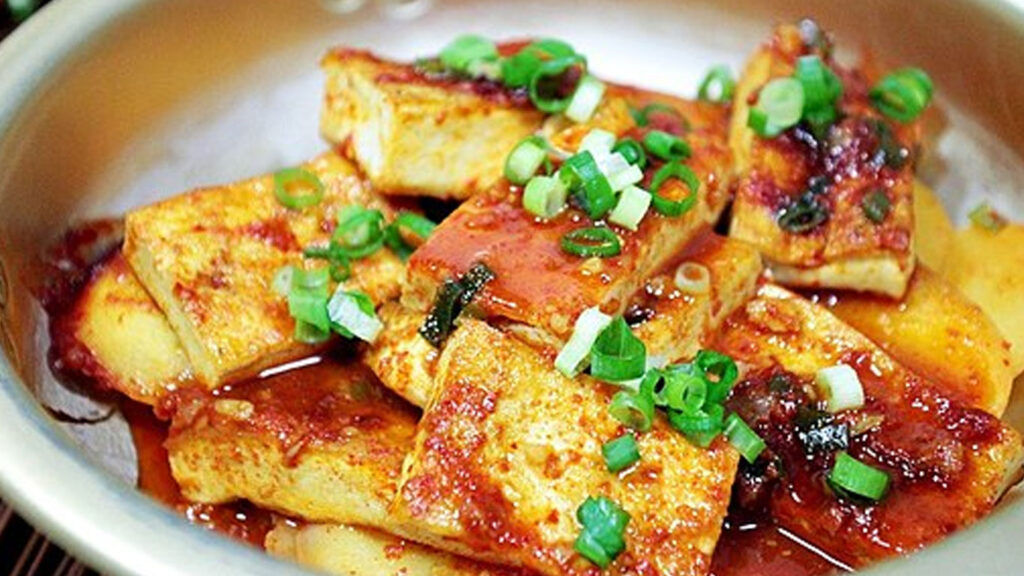
Ingredients:
- 1 package of firm tofu, cut into 1-inch cubes
- 2 cloves garlic, minced
- 1 tablespoon soy sauce
- 1 tablespoon sesame oil
- 1 tablespoon brown sugar
- 1/2 cup water
- 2 green onions, thinly sliced
- 1/2 teaspoon red pepper flakes (optional)
Instructions:
Heat sesame oil over medium-high heat in a large pan. Add minced garlic and stir-fry for 30 seconds until fragrant. Add the cubed tofu to the pan and cook until lightly brown on all sides, about 5-7 minutes.
In a small bowl, whisk together soy sauce, brown sugar, and water. Pour the sauce over the tofu and bring it to a boil. Reduce the heat to low and simmer for 5-7 minutes, or until the sauce has thickened and the tofu is well coated. Stir in sliced green onions and red pepper flakes and serve hot.
5. Vegan Kongnamul Guk (Soybean Sprout Soup)
This light and refreshing Korean soup is made with soybean sprouts, vegetable broth, and various aromatics such as garlic and green onions. It’s a nutritious and low-calorie soup that’s perfect for a healthy meal.
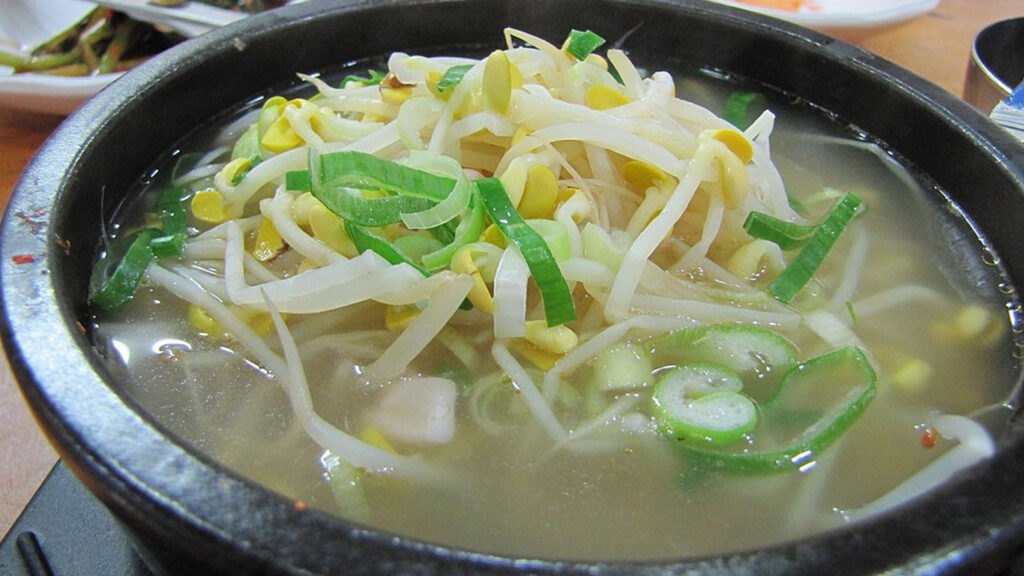
Ingredients:
- 4 cups soybean sprouts, washed and drained
- 6 cups vegetable broth
- 3 cloves garlic, minced
- 1 tablespoon sesame oil
- 1 tablespoon soy sauce
- Salt and pepper, to taste
- Green onions, thinly sliced, for garnish
Instructions:
In a large pot add sesame oil and heat it over medium-high heat. Add minced garlic and stir-fry for 30 seconds until fragrant. Now add the soybean sprouts to the pot and stir-fry for 2-3 minutes until slightly wilted. Add the vegetable broth to the pot and bring it to a boil. Reduce heat to low and simmer for 10-15 minutes, or until the soybean sprouts are fully cooked. Stir in soy sauce and season with salt and pepper to taste. Garnish with sliced green onions before serving.
Bonus Recipe
Kimchi
Kimchi has been a staple of Korean cuisine for centuries, and it is also enjoyed by people in other parts of the world. It is known for its distinctive sour, spicy, and umami flavor profile, as well as its nutritional benefits.
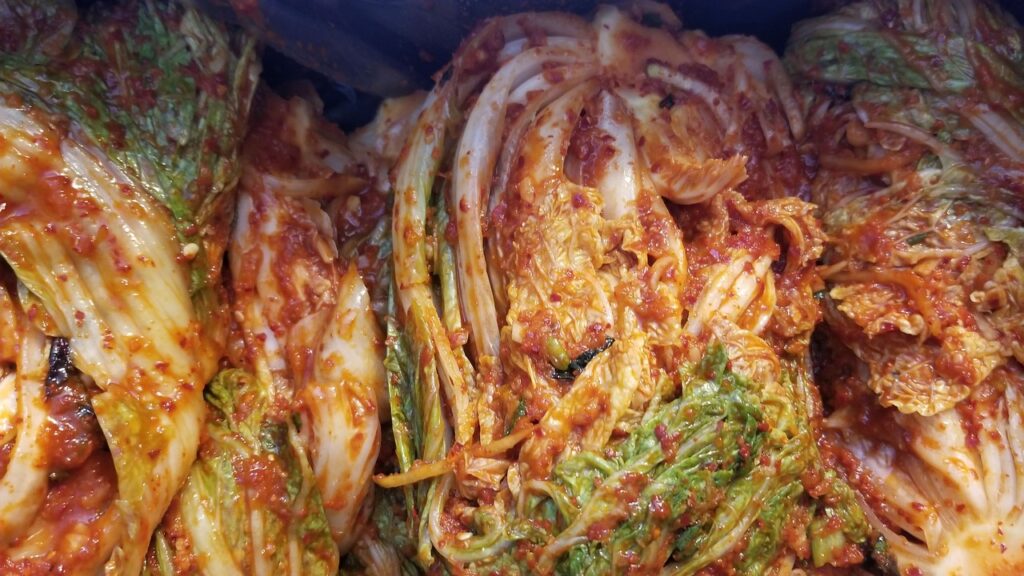
Ingredients:
- 1 head napa cabbage, about 2 pounds
- 1/2 cup coarse sea salt
- 8 cups cold water
- 1 tablespoon glutinous rice flour
- 1/2 cup water
- 1/2 cup Korean red pepper flakes
- 1 tablespoon minced garlic
- 1 teaspoon grated ginger
- 2 tablespoons fish sauce
- 2 tablespoons sugar
- 6 green onions, thinly sliced
- 1/2 cup daikon radish, peeled and julienned
Instructions:
Cut the cabbage into quarters and remove the core. Cut each quarter into bite-sized pieces. In a large bowl, mix the cabbage with the sea salt and water. Let it sit for 2 hours, turning the cabbage every 30 minutes. Rinse the cabbage thoroughly and drain well.
In a small saucepan, mix the glutinous rice flour with the water and cook over medium heat, stirring constantly, until the mixture thickens. Let it cool.
In a large bowl, mix the cooked rice flour paste, red pepper flakes, garlic, ginger, fish sauce, and sugar. Add the green onions and daikon radish to the seasoning paste, then mix in the cabbage until it is well coated with the seasoning paste.
Pack the kimchi tightly into a large jar, pressing down on it with a spoon or your hands to release any air bubbles. Leave the jar at room temperature for 1-2 days, then transfer it to the refrigerator. It will continue to ferment slowly in the refrigerator and will be ready to eat after about a week.
We hope you enjoy these healthy Korean recipes!


